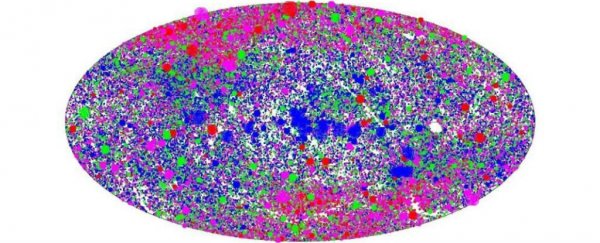Gazing up at the night sky is a guaranteed way of reminding yourself how vast our Universe is, but what you can see with the naked eye is obviously only a minuscule part of what's out there.
To really understand the vastness of space, you need something like the Max Planck Institute's all-sky survey, which is described as the most comprehensive look at the objects in our sky ever completed.
As Gizmodo reports, a brand new version of the sky map has just been published, and it's breathtaking in its intricacy.
The new chart updates a previous one completed in 1990, and was compiled with the help of the now-defunct ROSAT X-ray satellite. Thanks to improved image-processing technology and better algorithms, the astronomers working on the map have now been able to go into more detail than ever before.
The map's official name is the 2RXS Catalogue (replacing the original 1RXS one), and it essentially pinpoints the sources for every known body emitting X-ray radiation in our sky.
Crucially, it improves the reliability of the catalogue using the latest scanning techniques, although the first map was itself groundbreaking in its own right - the ROSAT X-ray satellite was responsible for increasing the number of known X-ray sources by a factor of around 100.
"Because of the extreme sensitivity and low background of the ROSAT PSPC instrument, cosmic X-ray sources can be identified with the detection of just a few photons," explains the team behind the newly published map. "These are sometimes difficult to distinguish from random fluctuations, and the new catalogue provides an assessment of this effect, based on simulated data."
For the astronomy community, it means an opportunity to study the night sky with more information and more accuracy than ever before, although the 2RXS map won't remain the definitive map of the sky for long.
The eROSITA X-ray survey telescope is expected to launch into orbit in 2017, and should tell us even more about what's out there in space - it's built to detect radiation up to 10 keV, whereas ROSAT was restricted to detecting signals in the 0.1-2.4 keV energy band.
It's hoped that the new satellite will tell us more about the mysterious dark energy that scientists think is accelerating the expansion of the Universe.
Right now, the presence of this dark energy is just a hypothesis, but researchers think it could be responsible for more than two-thirds of the total energy in the observable Universe.
In the meantime, 2RXS should be enough to keep astronomers busy.
The finished map has now been published in the journal Astronomy & Astrophysics.
